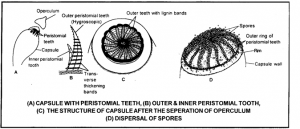W.B.C.S. Examination Notes On – Spore Dispersal In Funaria – Botany Notes.
In moss, when the mature capsule begins to dry up, the thin walled cells of the annulus break and the operculum is thrown away. Dropping off the operculum is assisted by the outward hygroscopic movement of the underlying peristomial teeth. Due to this movement, slits between the inner thin walled peristomial teeth become wider and spores escape gradually through these slits.Continue Reading W.B.C.S. Examination Notes On – Spore Dispersal In Funaria – Botany Notes.
In a wet atmosphere, the wet peristomial teeth bend inwards and thus closing the slits and prevent the escape of spores. The seta of the mature sporophyte also exhibits hygroscopic movements. In dry weather, by loosing water, it twists and bents, thus helping in dispersal of spores. The sporogonium of Funaria is photosynthetic, hence semi-parasitic on gametophore. It differentiates into foot, seta and capsule. The foot embedded in the female receptacle and absorbs inorganic nutrients.
With the exception of one group of mosses (Graphite mosses), all moss capsules have an operculum and peristome.
The general dispersal mechanism is as follows. Under dry conditions:-
- the calyptra (remnant of the archegonium) drops off
- the operculum is shed as a result of water loss by the annulus
- the peristome teeth bend outwards
- spores fall out of the capsule and are carried by air currents
The peristome teeth are triangular two-ply structures which operate like trap-doors. One layer tends to readily absorb or lose moisture while the other has little affinity for water. What this means is that as water is lost one side of the peristome teeth shrinks while the other does not. This results in a bending of the teeth outward.
Development of gametophyte from sporophyte without the formation of spores is known as apospory. Any vegetative cell of the sporophyte may form green protonemal filaments which bear lateral buds. These buds later develop into leafy gametophores.
The gametophores thus formed are diploid. Sexual reproduction in such gametophores results in the formation of tetraploid (4n) zygote. The sporophytes from tetraploid are sterile because they are not capable of bearing spores.
Sexual reproduction is oogamous. Male reproductive structure is known as antheridium and female as archegonium. Funaria is monoecious (having male and female sex organs on the same thallus) and autoicous (antheridia and archegonia develop on separate branches of the same thallus). Sex organs are borne on leafy gametophores in terminal clusters.
The main shoot of the leafy gametophore bears antheridia and act as male branch. Female branch develops as a lateral outgrowth from the base of the male branch and bears archegonia. It grows higher than the male branch. Funaria is protandrous (antheridia mature before the archegonia). It ensures the cross fertilization.
Please subscribe here to get all future updates on this post/page/category/website


 +919674493673
+919674493673  mailus@wbcsmadeeasy.in
mailus@wbcsmadeeasy.in







































































































